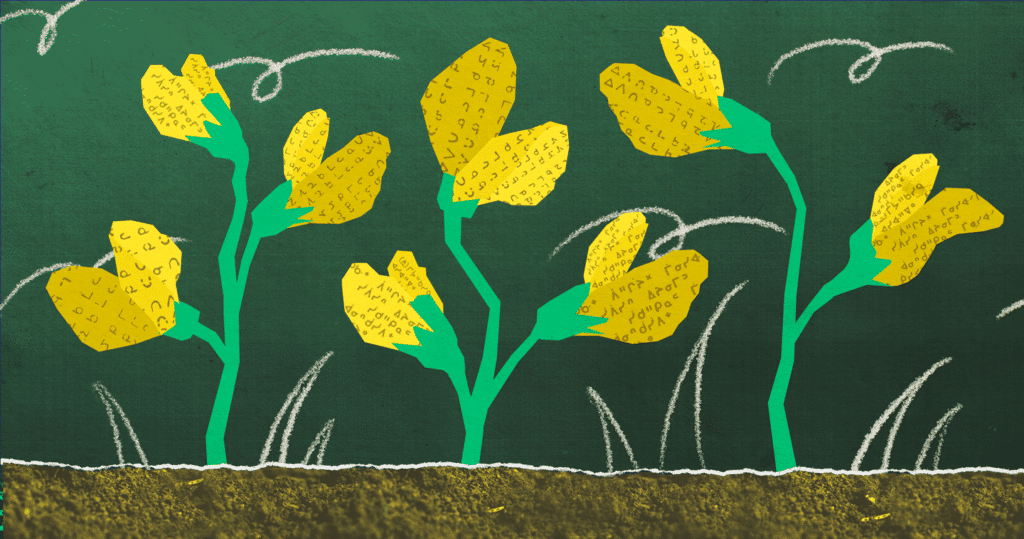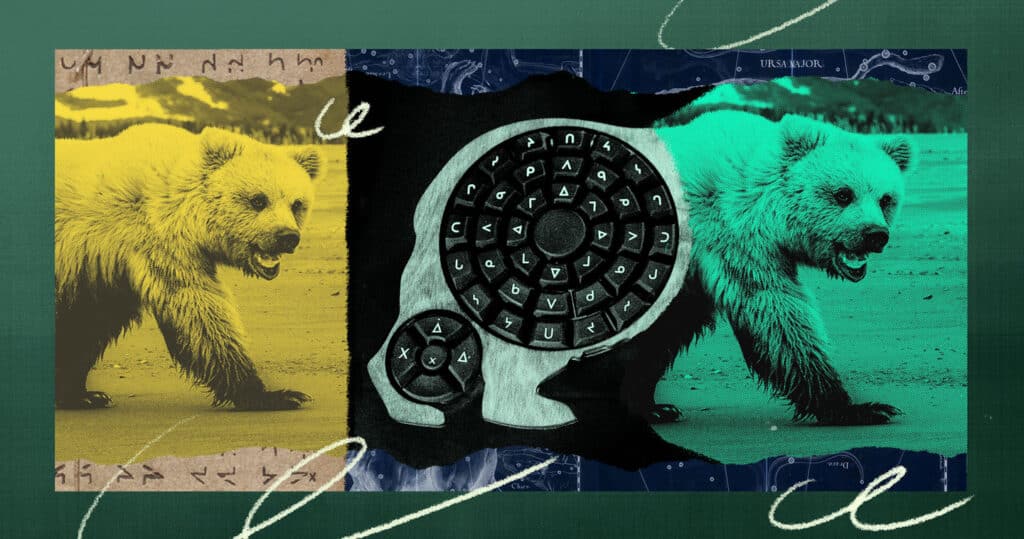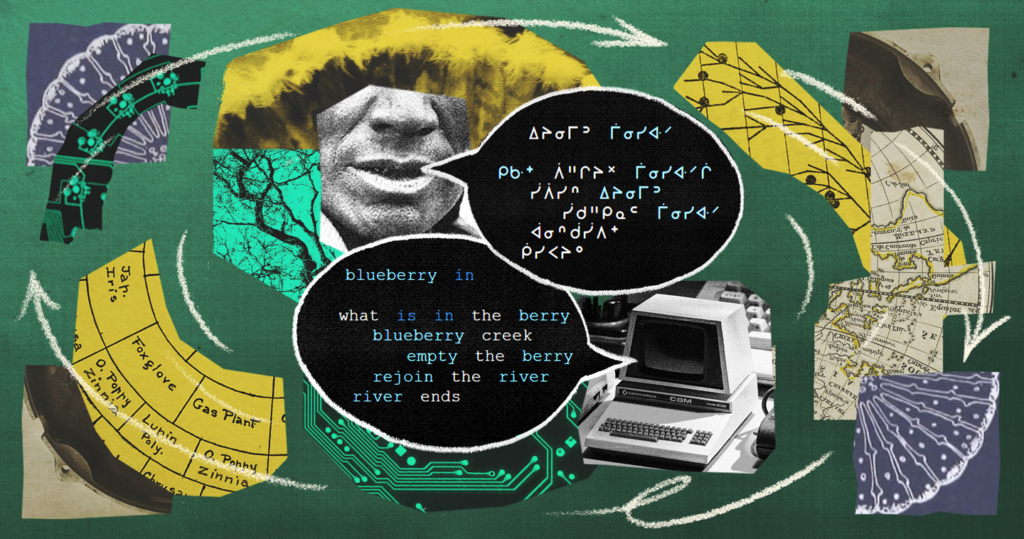From Colonial to Colloquial: AI and Indigenous Languages
It is estimated that one language dies every 14 days, with it a world of concepts and ideas that could only be expressed in its words. Most of the languages at risk of extinction belong to Indigenous communities.
AI and language processing have emerged as powerful tools that could help keep languages from vanishing. However, these technologies are largely built on and for Western languages, their cultural values, and worldviews—constructs that threaten to re-colonize the same languages they are trying to preserve.
How do you say computer in Cree?
Jon Corbett is a Nehiyaw-Métis computational media artist, computer programmer, and assistant professor at Simon Fraser University’s School of Interactive Art & Technology in British Columbia.
Corbett witnessed how his family’s languages and culture were lost over generations. “My grandmother on my father’s side was Cree and Saulteaux, but she suppressed that language, refused to acknowledge that there was any Indigenous blood in our family,” he said.
The story is not unique to Corbett’s family. Canada’s history bears centuries of Indigenous oppression, including forced familial separation that severed ties to culture and language.
“You can actually track, through the Canadian census, this removal of Indigenous culture and languages over the years,” said Corbett.
Corbett wanted to revitalize the Cree language for himself. So, he turned to what came easiest to him: programming.

Corbett has been programming computers since he was 10 years old. He thought that by creating a programming language in Cree, he could quickly pick up his ancestral tongue. But as he began studying Nehiyaw (the Plains Cree language), he realized many concepts are simply not transferable between computer theory and Indigenous knowledge.
“The first question I asked in class was, ‘How do you say the word computer?’” he said. “Well, we don’t have a word for computer.”
But more than that, Corbett understood that programming is filled with Western constructs he could not immediately replicate into Cree.
“I saw the loss of common things that I use in programming, like a loop or a conditional statement,” he said. “I need to know variables. I need to know mathematics. All of those components don’t exist. How do you write ‘if A==B, then do C,’ if there’s no language logic to fabricate that sentence?”
AI and Indigenous languages
It’s no surprise that current AI models struggle with Indigenous languages. Languages like Cree are polysynthetic, allowing for entire sentences or clauses to be expressed in a single word that seamlessly blends subjects, objects, and grammatical nuances. Corbett explains that this synthesis may appear contradictory in English but holds validity in Cree due to the rich contextual layers that make up the language’s structure.
“The Cree language and most Indigenous languages are very descriptive and poetic. If you do literal translations of them, they describe what is going on rather than a word. It’s a stark difference to how we construct words or code in English,” he said.
Surprisingly, if you ask ChatGPT to translate words into various Indigenous languages, it will magically fill up your screen. But often, with what experts deem as pseudo, made-up answers.
Part of the problem is the linguistic construct and the absence of cultural context within computers and programming languages. But it’s also that AI is only as good as its dataset. AI relies heavily on the quality and quantity of available data, and there is not a lot of data for Indigenous languages—particularly those with only a handful of speakers.
But even data on a language like Cree, which has more than 100,000 active speakers, is fraught with issues influenced by bias, stereotypes, or unethical practices.
There’s a long history of researchers obtaining Indigenous data without informed consent, disregarding Native customs, or failing to prioritize community benefit.
For Corbett, these challenges necessitated a new approach.
Indigenous computing framework
For the past seven years, Corbett has been working on Cree#, a language that allows programming in Cree keywords using Cree concepts and metaphors.
The more he ran into challenges turning an ancestral language into code, the more ambitious his pursuit became. Ultimately, he began trying to create an Indigenous computing framework, a framework of Indigenous concepts for hardware and software design.
“I believe the philosophy of computing and programming languages needs a different perspective. I want to approach this from a cultural perspective and fill in those gaps and those [computing] concepts with Indigenous ideas of what those represent,” said Corbett.
One of his first hardware undertakings was creating a Cree keyboard. “I started working on a layout,” he said. “But I was going through that and asked myself, ‘Why am I using a QWERTY keyboard?’ It doesn’t fit the language; it doesn’t even fit English!”
In his latest iteration, Corbett designed a circular keyboard inspired by the Cree syllabic star chart. The syllabic orthography of Cree—the way of writing Cree by using characters that represent different syllabic sounds—is often taught using a star-shaped chart, with sacred symbolism embedded in the cardinal directions.
Contrary to popular belief, cartographic directions are not universal. Corbett explained that the idea of North as up is a Western convention originating from European colonial expansion. It has no scientific basis.
In Cree star charts, the orientation of North faces downward, not upward. Corbett’s PCB (Printed Circuit Board) design reflects this cultural understanding. The microprocessor occupies the left side of the board, representing the East—the direction of the rising sun, a conduit of knowledge in his culture. The keyboard’s circuits follow a clockwise path, mirroring the way his people circumnavigate a lodge during ceremonial entrances.
“I’ve created this string that accounts for all of those ideas right down to the logical levels of communication, both digitally and analog,” said Corbett. “I’ve infused it with my cultural understanding of our nation and our language and how it can be used in a modern digital context when you don’t have the language to translate ‘What is a computer.’”

Resistance and rejuvenation
Corbett hopes programming will resonate with young people and help them embrace their ancestral tongues. He admits that he hasn’t been able to convince his own kids yet, though, nor much of the greater community.
“There’s a resistance from elders in the community who didn’t get a chance to grow up with computers or didn’t have exposure to computers,” he said. “They don’t see the relevance to our culture, and they’re skeptical and weary of their contribution. Part of that is that for Indigenous people in North America, their language has been suppressed and their culture oppressed, so they’re weary of technology and what it can do. But also, they see the negative impacts of computing and technology—how we are so attached to our devices, so enthralled with our screens, that you can’t pull somebody away.”
Corbett believes Indigenous-led, Indigenous-inspired, and Indigenous-sovereign projects are essential for technology to partake in rejuvenating languages.
“It’s important that language is preserved in a way that is protected,” he said. “There is knowledge that is not intended to be shared with people who are not members of the community.”
This is one of the unexpected outcomes of Corbett’s undertaking—the ability for programming to safeguard his culture. “By encapsulating the coding environment, only those with access to the source code—language and culture—can read it in its original form,” he explained. Outsiders can witness the output without accessing the actual language behind it.
In a world where languages vanish with the passing of time, Corbett is exploring a new approach to empower and protect his heritage tongue.
“I think initiatives like mine go a long way to helping others access a language from their own communities and giving them a platform to be able to use it,” he said. “I’m really hopeful that it could be used in that way.”
Artwork by Chris Connolly




